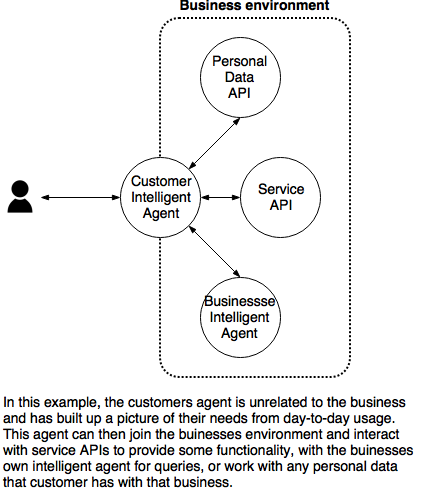
If anything defines the business landscape in the modern world over the last few years it is the increasing sophistication of technology, the ever-quickening pace, complexity, scale of data, and dropping of costs. The power of the tools now available to organisations is incredible. With one click we can add massive data lakes, machine learning, and personal AI assistants, let alone the day-to-day underlying traditional compute uses we are more familiar with. What also seems clear however is that we aren’t able to keep pace with the availability of technologies in the majority of cases. Amazon and Google scale companies, and others whose businesses are essentially reliant on staying at the front-edge of technology, are able to harness the power of new functionality, their survival requires it. But what of the rest of the businesses out there, those who’s primary driver is not necessarily technological?

In the above figure we can differentiate the broad categorisation of businesses by their degree of technology utilisation. At the very top we can see the highly automated and increasingly AI driven businesses running at the cutting edge of productionised technologies. These are the big players like Facebook and Google, and other such companies that may be running global installations of self-constructed data-centres. Business decisions and user testing are increasingly, and in some cases entirely, driven by machine learning and AI. Operations are at such scale and sub-millisecond speed that human beings are not involved in real-time, now part of the design, engineering, and evaluation of processes and software out of band.
The layer below shows what we might class as a well run modern business. There might be a heavy use of online SaaS services to run the business efficiently. Operationally a lot of the day-to-day services might be handed over to online cloud specialist companies in those services. The manual procedures for working with customers and administration are still there, but are made more efficient and coherent by utilising new technologies.
Lastly we have the bulk of businesses in the real world, and where the majority of small to medium businesses will find themselves. Notably this is not a indicator of businesses that are struggling in todays market, many will be very successful. Although, this will be reliant on a level playing field, in other words, the business and its competitors all function in the same layer. They may also be very well run businesses, using cloud office and simple email to form decent businesses processes, deliver good services to customers, and offer good growth value.

One thing should be clear from these descriptions, a company cannot compete with a competitor in a layer above it. The efficiency, scale, reliability, and advanced ‘added-extra’ functionality that can be offered to the marketplace grows exponentially as we move up the pyramid. As in any previous marketplace, any company that finds itself trailing competitors will need to rapidly evolve its business technologies to emulate or surpass others efficiency and services. The difference now is that that evolution needs to occur in the space of months, and react to tectonic technological shifts that may require altering the foundations of the business many times a year. The question becomes, how do we design our organisations to not only exist with this pace of change and advancement, but thrive in it?
Setting clear focus
The first thing we need to do when designing a business with modern technologies as its fabric is to make sure we’re being strict about asking the age-old ‘What does this business do?’ question. What is our market differentiator? How do we focus our limited time and resources in the most productive and useful way? Anything else should be either a generic organisational function, or in the sights of an off-the-shelf third party service. This question can be easier to answer in a non-technical world than in an technical one. A common pattern is for a business to come to the right conclusions, but extrapolate too far what functionality must live inside the business or be innovated. In looking to provide some form of digital services we might rightly think of ourselves as having a high degree of similarity to a software company, developing and iterating software services tailored to our unique services. However, in doing so we can pull in too much. Building and operating digital services is unlikely to require building a tailored compute platform to run them, or our own logging and auditing functionality, or any of the other pieces that prove substantial time-consumers to implement in a sustainable and highly available manner when starting from scratch down a handmade pathway.

Misunderstanding the boundaries of where we need to focus, and where we need to leverage external services and cloud functionality can severely delay time to market and increase the risk of a fragile and difficult to maintain software and operational base. All too often it can also lead to ‘build-shock’, where we pass through the exciting and flexible development phase, into a more stable operation and evolution phase. This is where the burden of our operational debt truly kicks in, we must maintain a degree of expertise to maintain our handmade technologies that is difficult to attract in this less free-form phase. Bringing in people to build exciting technologies is a lot easier than bringing people in to patch and maintain them, but both of these phases inherently require the same level of expertise.
We are also spread diffusely across a number of platforms, each of them absorbing our time and resources whether they are business-specific services or generic operational ones. It is at this stage of a businesses maturity that separates out a successful future from a more challenged one. In other words, those companies who are maintaining non-functionality specific diverse code bases, with the difficulties and costs associated with that, will be under threat from those companies that were more tightly focussed on their target and have all their resources aimed at their marketable services, iterating them and adding higher level functionality and value.
Smoothing operations
With clear definition on what is inside and outside of our in-house technical targets, we can focus on leveraging existing cloud technologies to do all of the non-business specific heavy lifting. The details of a typical base enterprise layout might be varied, some functionalities might be combined or separated depending on the scale of the operations, but the principles should be fairly common. The networking and security should be following industry standard templated layouts, there are few use cases that require something bespoke, especially when we have abstracted up a layer and are utilising more containerised or serverless technology. Companies will often assume that the software and underlying servers or compute solution will be the vast bulk of their work, only to find that the core operational aspects such as CICD pipelines, log shipping, consolidation, analytics, alerting and auditing become extremely time-consuming. These pieces of a live platform are actually a combination of a number of interlinked services that all come with an operational cost and maintenance burden. If nothing else, offloading these onto a cloud-managed service will substantial increase the ease of innovation on core business aspects of your added value development.
In reality if you aren’t off-loading these base components of live systems onto your cloud provider or a third-party, then your competitors that have will be working much more efficiently on providing market services than you are. And while you are still wrestling with the complexities of running a stable and sustainable logging platform, or debugging your self-managed data pipeline, they will be pulling in customers and business. When new technologies arrive that can deliver cutting edge services to their customers, you are bogged down in maintenance and upgrade debt on previous choices, with the timeframes and complexity of migrating onto more easy to manage or modern technologies increasing immensely as you balance developing with maintaining high-availability live services. There is an eventual outcome where effectively you’re now competing with companies working at a higher technical abstraction, a competitive disadvantage that no amount of money or people can easily close.
Insight and strategy
The explosive growth in available data, personal and otherwise, in many ways has been the decisive factor in the corresponding growth in machine learning and AI technologies. Translation services and individualised content shaping are heavily reliant on the availability on large masses of relevant data. In recent years we’ve also seem the commercialisation of trade-secret, trained machine learning patterns. Where the product is not a framework, but the data-shaped algorithms that lie on top.
What is notable is that the amount of data used to create these products is vast, and favours utilisation by large tech companies where massive streams of constant data are available across multiple areas to be processed in their own data centres. In a world where entering competition with such big players exceptionally difficult, we might find specialist areas where we can develop intelligent services that aren’t as yet covered, but even if not, we can build on top of others intelligent services to move our businesses forward in huge leaps.
While there is a danger of isolating our customers from our business if we overuse intelligent technologies, the history of online business in many ways illustrates the other extreme, the isolation of customers from our business due to its generic and inflexible content and functionality. We’ve always had to tailor our services the best we can right across our target customer groups rather than individual direct content flows and services that are designed specifically for them. Theres no reason to doubt that its exactly this individualisation of businesses, large and small, that people will come to expect. If a company cannot engage customers with reactive online presences that truly adapt to shape themselves to each persons ways of interacting with digital services, then they will struggle as more and more choose to.
The direction of travel in the cloud industry is shifting to give companies this ability, beyond what they could reasonably create or maintain. The release of Amazons Alexa, Polly, AI Translation, data-lake work, and MXNET integration shows us where a number of similar large companies are heading. The provision of AI services may be in its infancy, but it is deeply relevant not only to those large tech companies battling for dominance, but for the AI functionality that the market will begin to demand of even the most modest business. There are obvious implications for user-engagement, user research becoming a real-time AI driven shaping of our digital presence around the demands of individual customers. However, we should not only expect off-the-shelf machine learning to be driving future business insights, but AI should increasingly be driving how we set our direction at the management level too.
The centre of business
If we carry this concept of businesses receiving intelligent feedback to shape themselves to each customer, it may leads us to question where the core of our business lies, and how it behaves. Operationally we already look to find places in our live systems and operations that can be fully automated, setting up human-less loops that are more reactive, fault tolerant, with evaporating maintenance cost. Undoubtedly there is good reason to push forward more and more with this system automation work, putting people into the design and engineering roles where their previous workload of real-time operations shrinks. However, as we move human decision making and opinion from the real-time layers, it becomes apparent that perhaps the interaction we’re looking to provide is less and less human-customer to business, but instead from applications and virtual assistants representing that customers interests and the business API or functionality we provide to help satisfy that need.

In the above example, the customers agent is unrelated to the business and has built up a picture of their needs from day-to-day usage. This agent can then join the businesses environment and interact with service APIs to provide some functionality, with the businesses own intelligent agent for queries, or work with any personal data that customer has with that business.
With this in mind, we can make a conceptual switch in how we think about our business, and place the customers, or their intelligent agents, at the centre of our business processes. As an example, imagine we have a business that provides a number of different financial products. Traditionally we might have sales and marketing to sell those services to customers, and whatever array of systems and software backing them to enable them to function. In a world where customers begin to delegate more and more to their intelligent agents, the structure of our business fundamentally changes. We no longer design the organisation to meet the customers needs, but instead create a set of endpoints that can interact with those agents, and an environment where those agents can easily enter, discover services, and interact with them. In this view, our systems might be though of as more passive, with the customers agents learning their owners needs and situation them investigating our services to recommend the best ones for that need, or not.
We’re looking to re-centre our business around those who use it. Our users automated agents will be their conduit and representative in our systems, and it is increasingly the interaction between these and our own automated and intelligent systems that will dictate our businesses health.
Where people live
With this description of the future of business, and with the collecting set of reports warning off the displacement of large sections of skilled jobs that are likely to be under threat with increasing AI and automation, it is easy to feel that there is less and less place in the workplace for people to be involved. Where do people fit in to this automated business? There is still reason to believe that this change may prove to be positive, at least in some areas. Such as those where interactions between people are at its core, but are often time-challenged due to large amounts of administration and planning. One obvious example of this in the present day would be healthcare and government as a whole. We see nurses, doctors, and other medical staff whose great strength is to be talking with patients and their families, having to dedicate large fractions of their time to tasks that could be easily automated or dedicated to AI management platforms. Similarly at a business level, much of the financing that could be channeled towards front-line staff is re-routed and absorbed by administration and management.
Although a large and complex organisation like the NHS might prove an easy example of where intelligence and automation should enhance the service and the truly allow people within it achieve more of what they want, this broader principle is applicable across most businesses. By designing for low-level automation, strategic AI, and agent-centred businesses we can move people out of these business areas and into more productive and fulfilling ones.









